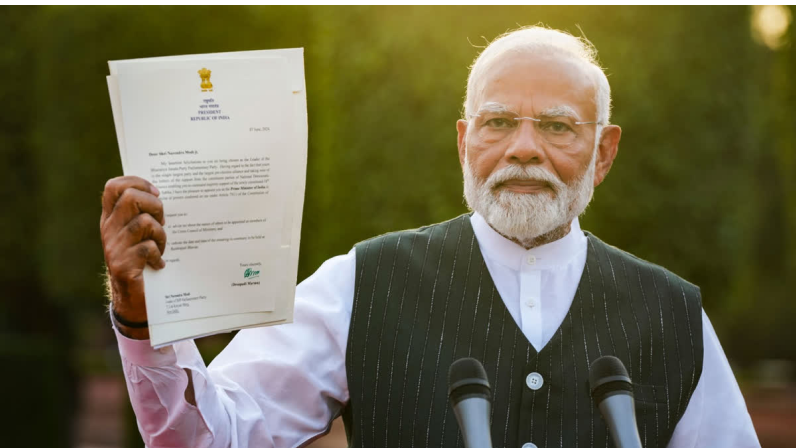Prime Minister-designate Narendra Modi took oath today for a third straight term as the head of a coalition government after two full tenures in which the BJP enjoyed a majority on its own. Mr. Modi, 73, equaled the feat of the first Prime Minister Jawaharlal Nehru, who won in the 1952, 1957, and 1962 general elections. After Mr. Modi, Rajnath Singh, Amit Shah, and Nitin Gadkari also took oath on Sunday alongside other Cabinet Ministers.
Early Life and Political Ascendancy Of Narendra Modi
In Vadnagar, Gujarat, on September 17, 1950, Narendra Damodardas Modi was born. Modi was a tea dealer at first, but he never gave up on his goals. His political career began with his early affiliation with the Rashtriya Swayamsevak Sangh (RSS). His ascension into the Bharatiya Janata Party (BJP) was facilitated by the prompt recognition of his strategic ability and devotion.
Modi’s political journey gained momentum when he was appointed Chief Minister of Gujarat in 2001. His tenure was marked by economic growth and infrastructural development, earning him both praise and criticism. The 2002 Gujarat riots, however, cast a long shadow over his administration, attracting widespread controversy and scrutiny.
The Road to Prime Ministership Of Narendra Modi
Modi’s transformative leadership in Gujarat positioned him as a strong contender for national leadership. The 2014 general elections saw the BJP, under Modi’s leadership, secure a resounding victory, ending a decade-long rule of the Congress-led United Progressive Alliance (UPA). Modi’s campaign, characterized by promises of economic reform, development, and good governance, resonated with a populace yearning for change.
Policies and Reforms of Narendra Modi
As Prime Minister, Narendra Modi embarked on an ambitious agenda to modernize India. His initiatives spanned various sectors, aiming to drive economic growth, technological advancement, and social welfare.
Economic Reforms: Modi’s government introduced significant economic reforms, including the Goods and Services Tax (GST) aimed at unifying the nation’s market, and the Insolvency and Bankruptcy Code to address the issue of non-performing assets. The “Make in India” campaign sought to transform India into a global manufacturing hub.
Swachh Bharat Abhiyan: Designed to improve sanitation and hygiene nationwide, the Swachh Bharat (Clean India) program was introduced in 2014. The campaign placed a high priority on eradicating open defecation, encouraging hygiene, and building toilets.
Modi’s foreign policy was centered on increasing India’s influence around the world. India’s strategic and economic interests were emphasized on the international scene by his multiple foreign trips and aggressive interactions with other leaders.
Social Welfare Programs: Under Modi’s leadership, a number of social welfare programs were implemented, such as the Ayushman Bharat plan (healthcare coverage for the poor), the Pradhan Mantri Jan Dhan Yojana (financial inclusion), and the Pradhan Mantri Ujjwala Yojana (LPG connections for rural households).
Digital India: The Digital India initiative aimed to enhance digital infrastructure and connectivity, promoting e-governance and digital literacy. This program played a crucial role in increasing internet penetration and fostering a startup ecosystem.
Challenges and Criticisms
Despite the achievements, Modi’s tenure has not been without challenges and criticisms. The government’s handling of issues such as demonetization in 2016, the implementation of GST, and the agrarian distress faced by farmers have sparked significant debate. Moreover, concerns over rising intolerance, freedom of speech, and human rights have been points of contention both domestically and internationally.
The Narendra Modi Legacy
With Narendra Modi in charge, India’s political history has entered a critical phase. During his leadership, the country has witnessed a combination of revolutionary programs and controversial choices that have had a lasting effect. Modi’s idea of a New India continues to be a major component in the country’s ongoing narrative as it helps India negotiate the complexity of a world that is changing quickly.
In conclusion, Narendra Modi’s rise from a modest background to the Prime Minister of India epitomizes a journey of resilience and determination. His leadership continues to shape India’s socio-economic and political trajectory, influencing the lives of over a billion people. As India progresses under his leadership, the nation’s story under Modi’s stewardship continues to unfold, offering new chapters of development, reform, and challenge.
Who is India’s New Prime Minister in 2024?
Narendra Modi
